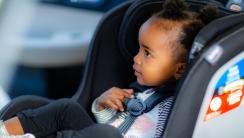Roberts Center for Pediatric Research 2716 South Street, 13th Floor Philadelphia, PA 19146
Breadcrumb
RESEARCH PORTFOLIO
Principal Investigator: Rachel Myers, PhD
The goal of this study is to create a unique source of epidemiologic crash data that enables novel description of use and installation patterns of child restraints among crash-involved children and— following linkage with hospital discharge and death certificate data—novel description of child occupant injury outcomes based on restraint use and installation (rear- vs. forward-facing).2025-2026
- Comparison of US and European Belt Paths of Rearward-Facing CRS in Frontal-Oblique Impact Sled Tests
Principal Investigator: Declan Patton, PhD
This study will perform frontal-oblique sled tests to compare the European and US belt paths used to attach rearward-facing infant CRS models in terms of head and chest injury metrics of a 12-month-old ATD.- Physical Testing of Front-Row Seatbacks
Principal Investigator: Declan Patton, PhD
Recent sled test studies have attempted to quantify the influence of the distance between the CRS and the front row seatback on head injury metrics. However, such tests lack the fidelity of full-scale vehicle tests. In this study, impact tests will be performed on a sample of front-row seatbacks using a pediatric ATD headform to quantify the relationship between the impact parameters and injury metrics.
2024-2025
- Interactions Between the CRS and Front Row Seatback in Full-Scale Vehicle Frontal Crash Tests
Principal Investigator: Declan Patton, PhD
This study builds on and enhances prior CChIPS research on the interactions between rearward-facing child restraint systems (CRS) and the front row seatback during frontal impacts. Using the Transport Canada full-scale vehicle crash test database, investigators will further characterize the interactions between the anthropomorphic test device (ATD) head and/or CRS and front row seatback during frontal crashes.
2023-2024
- Interactions Between Rearward-Facing Child Restraint Systems with a Support Leg and the Center Console in Frontal Impact Sled Tests
Principal Investigator: Declan Patton, PhD
Installing a child restraint system (CRS) in the rear center seating position of a vehicle is common, especially rearward-facing CRS, as it is anecdotally considered the safest position. Only one study has investigated the interactions between rearward-facing CRS models and the center console during frontal impacts, which found that CRS contact with a center console resulted in elevated peak resultant head accelerations.
2022-2023
- Frontal-Oblique Impact Sled Tests of a Rearward-Facing Child Restraint System With and Without a Support Leg
Principal Investigator: Declan Patton, PhD
This study aims to quantify the head and neck injury metrics associated with anthropomorphic test devices (ATDs) in rear-facing child restraint system models for frontal-oblique impacts.- Strength of Underfloor Compartments When Loaded with a Support Leg During a Frontal Crash
Principal Investigator: Declan Patton, PhD
This study aims to quantify the strength of child restraint system support legs and underfloor compartments using drop tests.
2021-2022
- Interactions Between Rear-Facing Child Restraint Systems and the Front Row Seatback in Frontal Impact Sled Tests
Principal Investigator: Declan Patton, PhD
The goals of this project are to quantify the head and neck injury metrics of the Q1.5 anthropomorphic test device (ATD) in a rear-facing infant child restraint system (CRS) and the Q3 ATD in a rear-facing convertible CRS during frontal impacts for position (i.e., braced, touching or 25 mm gap) and support leg use (i.e. with or without).
2019-2020
- ATD Responses in Rear-facing/Forward-facing Configurations in Frontal and Rear Impact Sled Tests
Principal Investigator: Declan Patton, PhD
This project aims to quantify the kinematics and kinetics of the Q6 and Q10 ATD installed in rear-facing/forward-facing configurations in frontal and rear impact sled testing.

